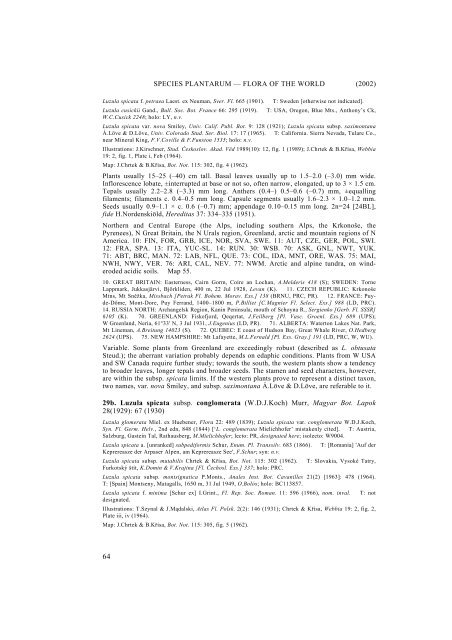Part 6. JUNCACEAE 1: Rostkovia to Luzula - Species Plantarum ...
Part 6. JUNCACEAE 1: Rostkovia to Luzula - Species Plantarum ...
Part 6. JUNCACEAE 1: Rostkovia to Luzula - Species Plantarum ...
Create successful ePaper yourself
Turn your PDF publications into a flip-book with our unique Google optimized e-Paper software.
64<br />
SPECIES PLANTARUM — FLORA OF THE WORLD (2002)<br />
<strong>Luzula</strong> spicata f. petraea Laest. ex Neuman, Sver. Fl. 665 (1901). T: Sweden [otherwise not indicated].<br />
<strong>Luzula</strong> cusickii Gand., Bull. Soc. Bot. France 66: 295 (1919). T: USA, Oregon, Blue Mts., Anthony’s Ck,<br />
W.C.Cusick 2248; holo: LY, n.v.<br />
<strong>Luzula</strong> spicata var. nova Smiley, Univ. Calif. Publ. Bot. 9: 128 (1921); <strong>Luzula</strong> spicata subsp. saximontana<br />
Á.Löve & D.Löve, Univ. Colorado Stud. Ser. Biol. 17: 17 (1965). T: California. Sierra Nevada, Tulare Co.,<br />
near Mineral King, F.V.Coville & F.Funs<strong>to</strong>n 1535; holo: n.v.<br />
Illustrations: J.Kirschner, Stud. Českoslov. Akad. Věd 1989(10): 12, fig. 1 (1989); J.Chrtek & B.Křísa, Webbia<br />
19: 2, fig. 1, Plate i, Feb (1964).<br />
Map: J.Chrtek & B.Křísa, Bot. Not. 115: 302, fig. 4 (1962).<br />
Plants usually 15–25 (–40) cm tall. Basal leaves usually up <strong>to</strong> 1.5–2.0 (–3.0) mm wide.<br />
Inflorescence lobate, ±interrupted at base or not so, often narrow, elongated, up <strong>to</strong> 3 × 1.5 cm.<br />
Tepals usually 2.2–2.8 (–3.3) mm long. Anthers (0.4–) 0.5–0.6 (–0.7) mm, ±equalling<br />
filaments; filaments c. 0.4–0.5 mm long. Capsule segments usually 1.6–2.3 × 1.0–1.2 mm.<br />
Seeds usually 0.9–1.1 × c. 0.6 (–0.7) mm; appendage 0.10–0.15 mm long. 2n=24 [24BL],<br />
fide H.Nordenskiöld, Hereditas 37: 334–335 (1951).<br />
Northern and Central Europe (the Alps, including southern Alps, the Krkonoše, the<br />
Pyrenees), N Great Britain, the N Urals region, Greenland, arctic and mountain regions of N<br />
America. 10: FIN, FOR, GRB, ICE, NOR, SVA, SWE. 11: AUT, CZE, GER, POL, SWI.<br />
12: FRA, SPA. 13: ITA, YUC-SL. 14: RUN. 30: WSB. 70: ASK, GNL, NWT, YUK.<br />
71: ABT, BRC, MAN. 72: LAB, NFL, QUE. 73: COL, IDA, MNT, ORE, WAS. 75: MAI,<br />
NWH, NWY, VER. 76: ARI, CAL, NEV. 77: NWM. Arctic and alpine tundra, on winderoded<br />
acidic soils. Map 55.<br />
10. GREAT BRITAIN: Easterness, Cairn Gorm, Coire an Lochan, A.Melderis 418 (S); SWEDEN: Torne<br />
Lappmark, Jukkasjärvi, Björkliden, 400 m, 22 Jul 1928, Levan (K). 11. CZECH REPUBLIC: Krkonoše<br />
Mtns, Mt Sněžka, Missbach [Petrak Fl. Bohem. Morav. Exs.] 138 (BRNU, PRC, PR). 12. FRANCE: Puyde-Dôme,<br />
Mont-Dore, Puy Ferrand, 1400–1800 m, P.Billiet [C.Magnier Fl. Select. Exs.] 988 (LD, PRC).<br />
14. RUSSIA NORTH: Archangelsk Region, Kanin Peninsula, mouth of Schoyna R., Sergienko [Gerb. Fl. SSSR]<br />
6105 (K). 70. GREENLAND: Fiskefjord, Qeqertat, J.Feilberg [Pl. Vasc. Groenl. Exs.] 689 (UPS);<br />
W Greenland, Neria, 61°33' N, 3 Jul 1931, J.Eugenius (LD, PR). 71. ALBERTA: Water<strong>to</strong>n Lakes Nat. Park,<br />
Mt Lineman, A.Breitung 14023 (S). 72. QUEBEC: E coast of Hudson Bay, Great Whale River, O.Hedberg<br />
2624 (UPS). 75. NEW HAMPSHIRE: Mt Lafayette, M.L.Fernald [Pl. Exs. Gray.] 191 (LD, PRC, W, WU).<br />
Variable. Some plants from Greenland are exceedingly robust (described as L. obtusata<br />
Steud.); the aberrant variation probably depends on edaphic conditions. Plants from W USA<br />
and SW Canada require further study; <strong>to</strong>wards the south, the western plants show a tendency<br />
<strong>to</strong> broader leaves, longer tepals and broader seeds. The stamen and seed characters, however,<br />
are within the subsp. spicata limits. If the western plants prove <strong>to</strong> represent a distinct taxon,<br />
two names, var. nova Smiley, and subsp. saximontana Á.Löve & D.Löve, are referable <strong>to</strong> it.<br />
29b. <strong>Luzula</strong> spicata subsp. conglomerata (W.D.J.Koch) Murr, Magyar Bot. Lapok<br />
28(1929): 67 (1930)<br />
<strong>Luzula</strong> glomerata Miel. ex Huebener, Flora 22: 489 (1839); <strong>Luzula</strong> spicata var. conglomerata W.D.J.Koch,<br />
Syn. Fl. Germ. Helv., 2nd edn, 848 (1844) [‘L. conglomerata Mielichhofer’ mistakenly cited]. T: Austria,<br />
Salzburg, Gastein Tal, Rathausberg, M.Mielichhofer; lec<strong>to</strong>: PR, designated here; isolec<strong>to</strong>: W9004.<br />
<strong>Luzula</strong> spicata a. [unranked] subpediformis Schur, Enum. Pl. Transsilv. 683 (1866). T: [Romania] 'Auf der<br />
Keprereasze der Arpaser Alpen, am Keprereasze See', F.Schur; syn: n.v.<br />
<strong>Luzula</strong> spicata subsp. mutabilis Chrtek & Křísa, Bot. Not. 115: 302 (1962). T: Slovakia, Vysoké Tatry,<br />
Furkotský štít, K.Domin & V.Krajina [Fl. Čechosl. Exs.] 337; holo: PRC.<br />
<strong>Luzula</strong> spicata subsp. montsignatica P.Monts., Anales Inst. Bot. Cavanilles 21(2) [1963]: 478 (1964).<br />
T: [Spain] Montseny, Matagalls, 1650 m, 31 Jul 1949, O.Bolós; holo: BC113857.<br />
<strong>Luzula</strong> spicata f. minima [Schur ex] I.Grint., Fl. Rep. Soc. Roman. 11: 596 (1966), nom. inval. T: not<br />
designated.<br />
Illustrations: T.Szynal & J.Mądalski, Atlas Fl. Polsk. 2(2): 146 (1931); Chrtek & Křísa, Webbia 19: 2, fig. 2,<br />
Plate iii, iv (1964).<br />
Map: J.Chrtek & B.Křísa, Bot. Not. 115: 305, fig. 5 (1962).












